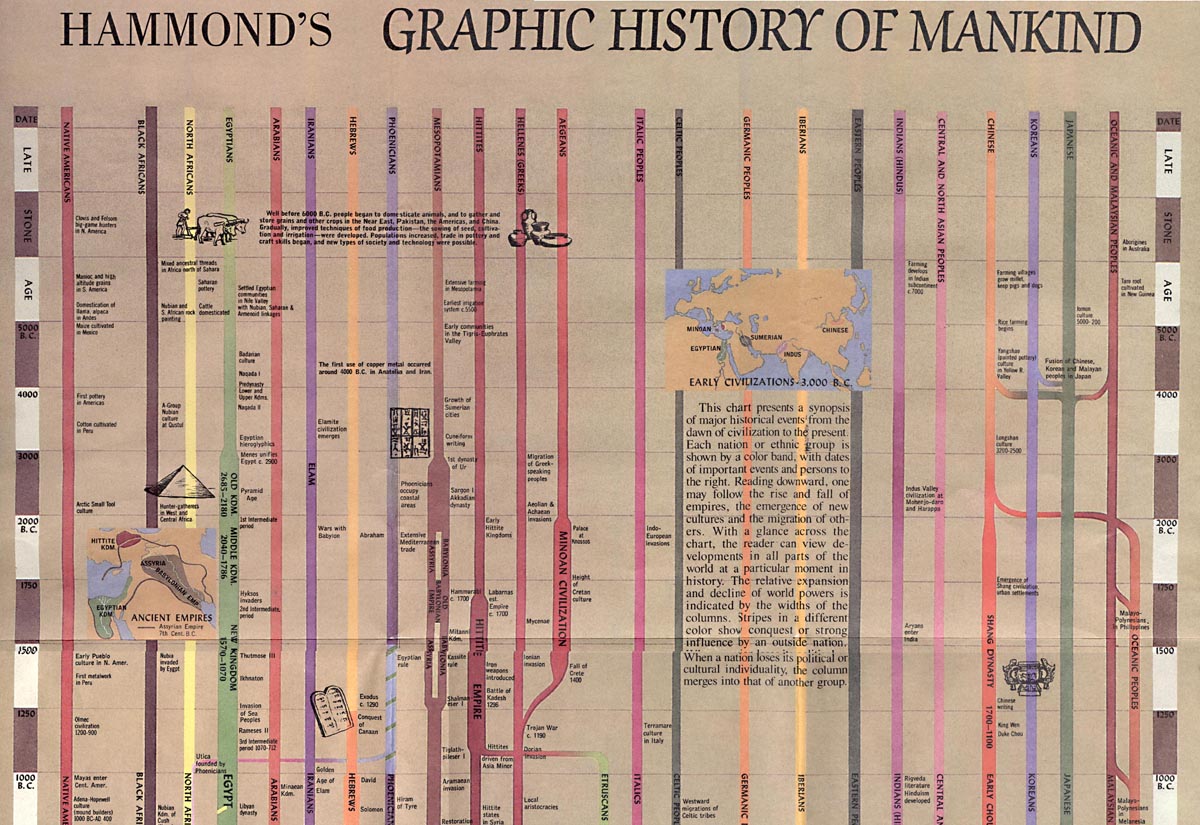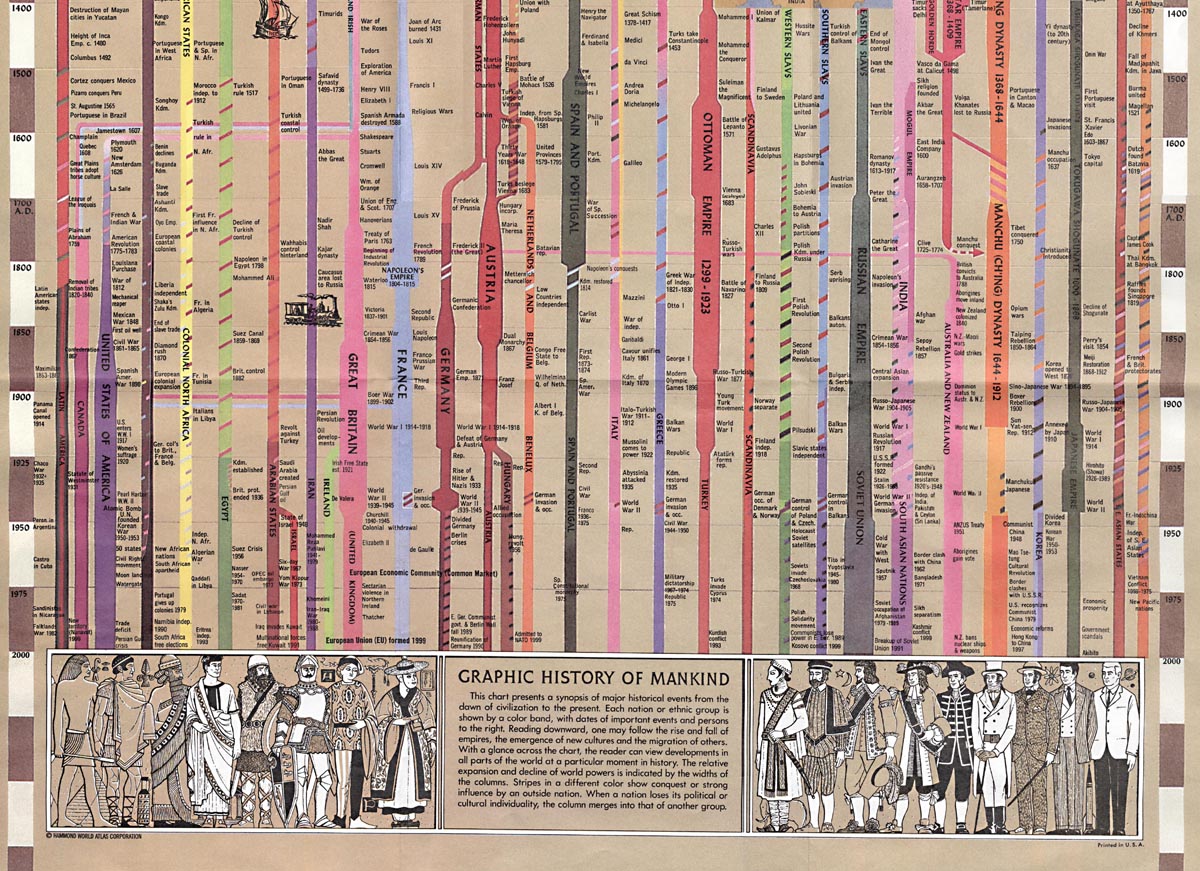How can you show the details of a history visually? Time provides
one obvious dimension. What else can you show to tell the story?
Most timeline charts use a 2D representation, time x {place or theme}.
Some are more successful in integrating additional dimensions.
This page is an annotated visual gallery of some timeline designs from
their origin to today. Although time is one-dimensional, telling some
story of history visually is much more complex, and it is quite
instructive to see together
how different graphic designers have aproached this problem.
Contents:
| Picture |
Words |
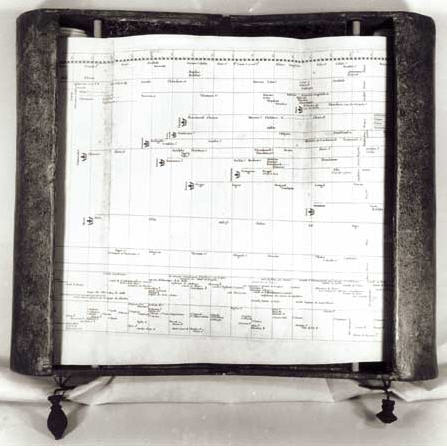
|
Carte chronologique.
Full size (447 x 448; 35K)
Description:
The earliest modern timeline was created by Jacques Barbeu-Dubourg (1709-1779) in 1753.
This ``Carte chronologique'' was an annotated timeline of history (from
Creation) on a 54-foot scroll.
It included names and descriptive events,
grouped thematically, with symbols denoting character (martyr, tyrant, heretic,
noble, upright, etc.) and profession (painter, theologian, musician,
monk, etc.)
|
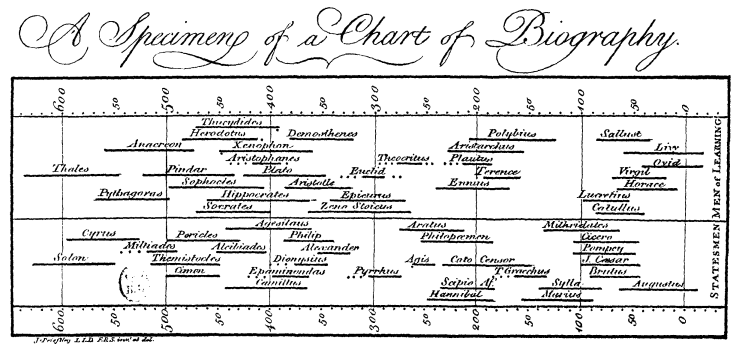
|
Joseph Priestley's Chart of Biography
Full size (739 x 353; 69K)
Description:
Joseph Priestley (1733-1804) was one of the first to attempt to depict historical events graphically.
This image, from 1765, was designed as a proof-of concept for a much large, more detailed version,
showing the lifespans of 2000 famous people, from 1200 B.C. to 1750 A.D.
Priestley divided the people into two categories: Men of Learning and Statesmen, and
and is credited with inventing the
idea of showing their lifespan by the length of a horizontal line.
He also invented the convention of using dots (...) to indicate uncertain birth and death dates.
|
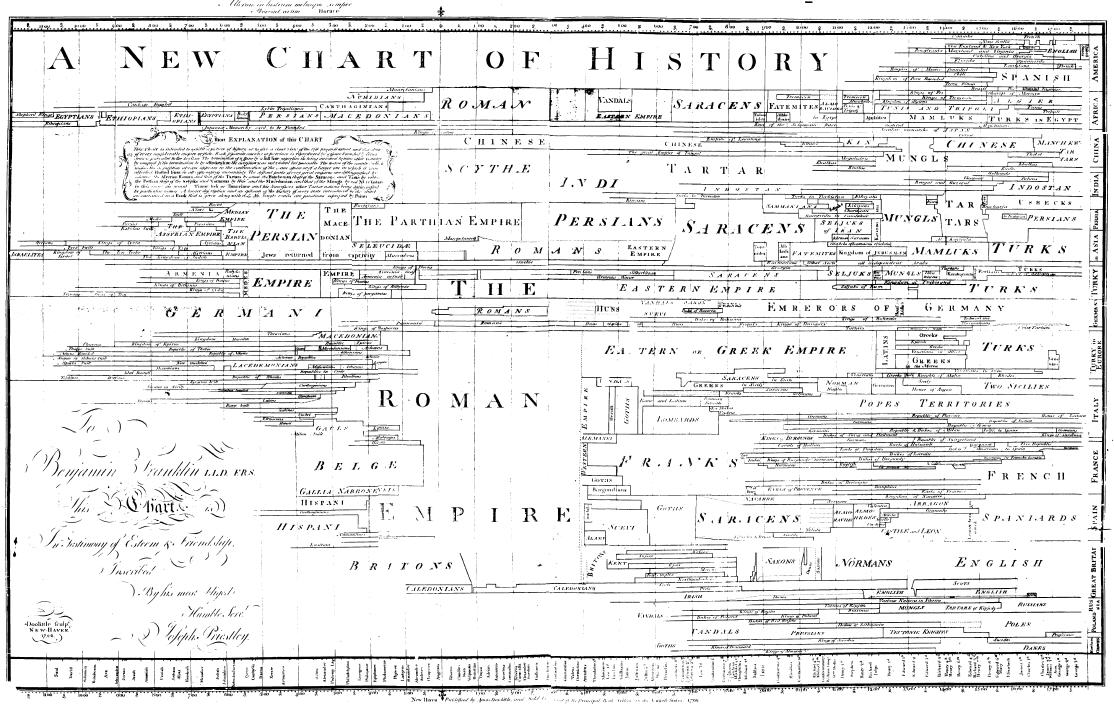
|
Joseph Priestley's Chart of History
Full size (739 x 353; 69K)
Description:
Priestley was interested in depicting history in a more comprehensive and analytic way.
His New Chart of History was published in several editions, starting around 1769.
|
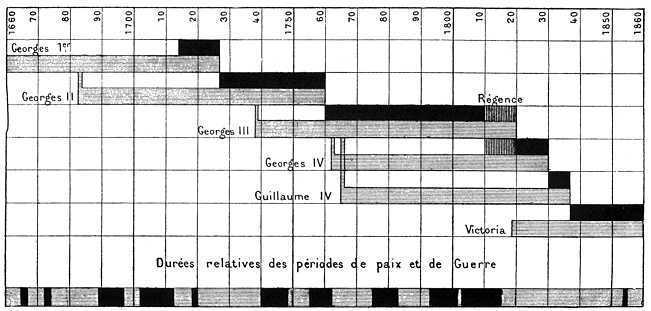
|
Reigns of English monarchs
Full size (651 x 311; 31K)
Description:
Etienne-Jules Marey (1830-1904) used this timeline in 1885 to show the reigns of kings and queens of England,
from 1660 to 1860, in relation to periods of peace and war.
|
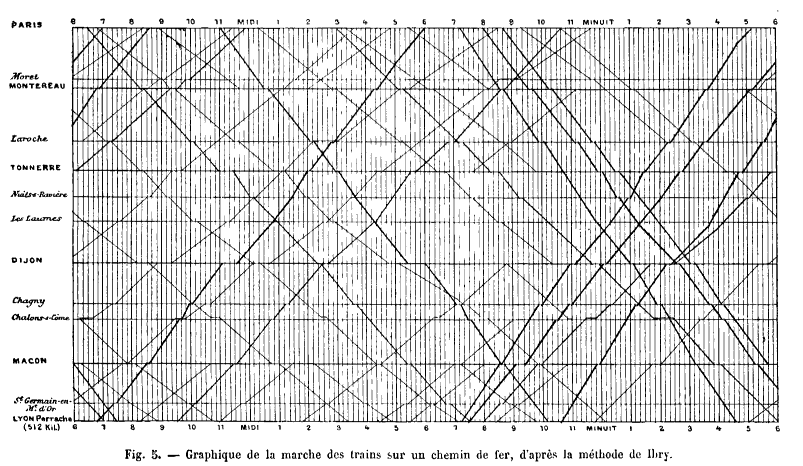
|
Train schedule string-line graphic.
Full size (803 x 466; 71K)
Description:
This diagram, showing the time schedules of trains from Paris to Lyon and vice-versa, was published by
Marey in his book, La Méthode Graphique (Paris, 1885), who attributed the design to the
French engineer, Ibry.
This design makes it easier to determine the fastest trains (steeper slopes), lay-overs (line breaks),
and the intersection points of south-bound and north-bound trains.
The design works as a graphic calculator because the stations are spaced on the vertical axis in
proportion to distance along the route.
Today, such diagrams are sometimes called ``string line charts,'' because they were often constructed by
using push pins and colored strings, in an attempt to optimize train schedules.
|
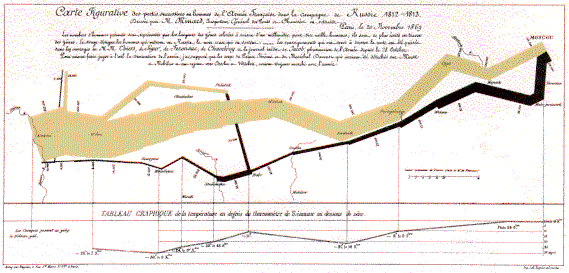
|
Minard's visual history of Napoleon's Russian Campaign.
Full size
Description:
The French engineer,
Charles Minard (1781-1870), illustrated
the disastrous result of Napoleon's failed Russian campaign of 1812.
The graph shows
the size of the army by the width of the band across the map of the campaign
on its outward and return legs, with temperature on the retreat shown on the line graph at the bottom.
Many consider Minard's original the best statistical graphic ever drawn.
But in essence, it is also a visual history, relating troop strength, geography, battles, and winter
temperature in a single image. E. J. Marey commented that Minard's graphic ``defied the pen of the
historian in its brutal elegance.''
|
There are a number of more recent charts of history that use graphic ideas similar to those of
Jacques Barbeu-Dubourg and Joseph Priestley, but attempt to add additional design features
to show a graphic history.
Telling stories of history in words provides for rich detail, analysis,
and subtlety, but the linear form of text does not provide for overview,
multiple layers or zoomable levels of detail -- abstraction that might
be possible in a visual representation.
| Picture |
Words |
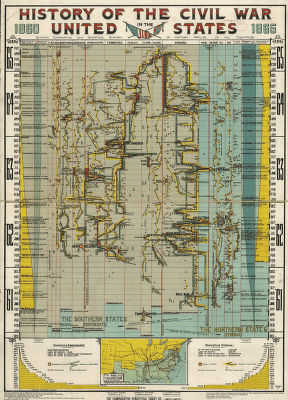 |
History of the U.S. Civil War. Full-size image 288 x 400 (101k)
This image, from the Library of Congress, Visual Memory Project,
History of the Civil War in the United States, 1860-1865
shows the progress of the war, with a time scale in months, and principal battles, troop movements, etc, using
"Scaife's comparative and synoptical system of history applied to all countries."
A reproduction may be purchased from the Kroll Map Company
|
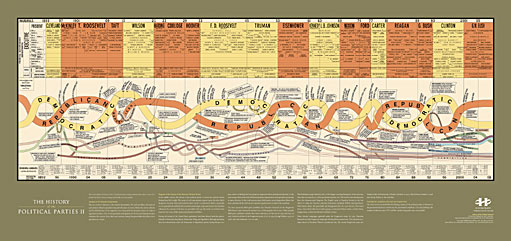
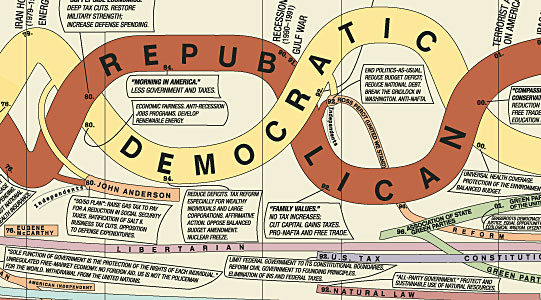
|
HistoryShots: History of U.S. Political Parties
Full image, medium size (511 x 241; 45K);
Full image, large (792 x 374; 164K);
Detail1 (541 x 300; 76K)
Detail2 (541 x 200; 52K)
Description:
These images are from one of a series of beaautifully designed, poster-size charts prepared by
Larry Gormley and Bill Younker of HistoryShots.
This one shows the history of the US political parties from 1892--2005, on a horizontal time scale
with details about political events, issues and administrations.
[Credits:
These images are Copyright © 2006 HistoryShots, LLC. All rights reserved;
used here by permission.]
|
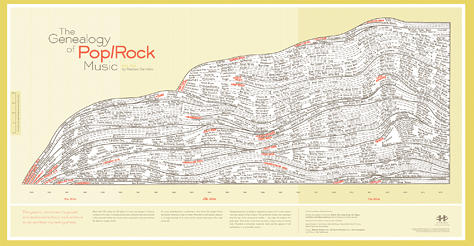

|
Geneaology of Pop/Rock music: Rock and Roll is Here to Pay.
Poster, 500px (474 x 246; 66K) ;
Scan from Tufte (1500 x 696; 456K)
Description:
This graphic was originally designed by Steve Chappel and Reebe Garofalo
in Rock 'N' Roll is Here to Pay: The History and Politics of the
Music Industry (1977). It was reproduced by
Tufte (1997, p. 90-91),
and most recently prepared as this poster by
HistoryShots.
It is partly a categorized genealogy of rock and pop music, indicating
the birth of stylistic categories in bold letters (RockaBilly, British Invasion, Acid rock, Country rock, etc.), and the individual timespans and legacies of particular
musicians and groups by arrows, on a horizontal time scale showing start/end
of influence.
Added to this is a vertical scale, showing the dollar volume of record
sales, presumably as a percent of total.
For more details, see the
Story behind the chart
[Credits:
The poster image is Copyright © 2006 HistoryShots, LLC. All rights reserved;
used here by permission.]
|

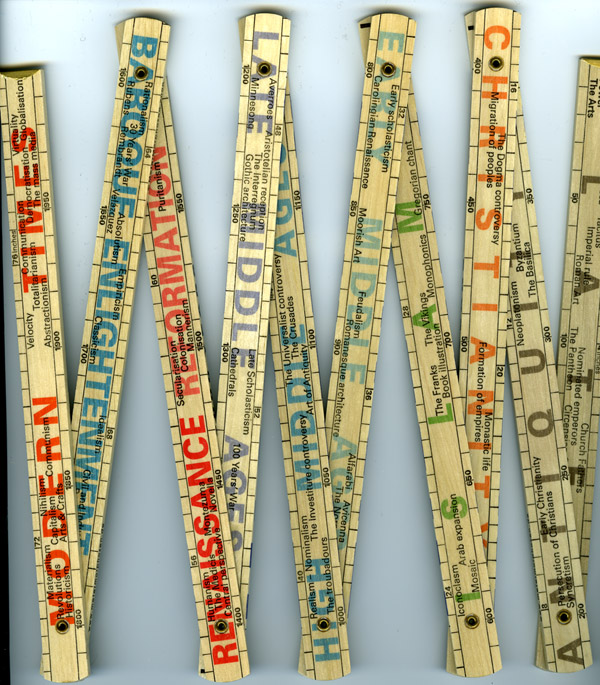
|
History by the Meter.
Closed view (600 x 76; 36K);
Epoch view (600 x 685; 193K);
Event view (600 x 670; 204K)
Description:
If you ever need to measure the distance between two historical events
or want a unique meter stick, History by the Meter, produced by
www.metermorphosen.de, is for you.
The epoch side
indicates historical epochs, in periods of about 200 years,
with a scale of 1cm = 10 years. Various themes (Nihilism, Colonization,
Gothic architecture) in three parallel streams of time
(Mind, Power, the Arts) are marked,
in the various named epochs of history.
The event side,
marked with a cm. scale, shows individual events in history,
including such delightful things as-- 10AD: 1st public library in Rome; 552: Silk worms arrive in Europe;
1015: Arabia: medical use of caffeine; 1335: Punch & Judy shows in Europe,
handguns.
|
What else was happening in the world around 1869, when Minard published his March on Moscow graphic?
Or around 1962, when the Beatles formed and transformed pop music with the release of Love Me Do?
Some visual histories try to show parallel timelines, so that one can see events in one domain
in the context of events in other areas.
| Picture |
Words |
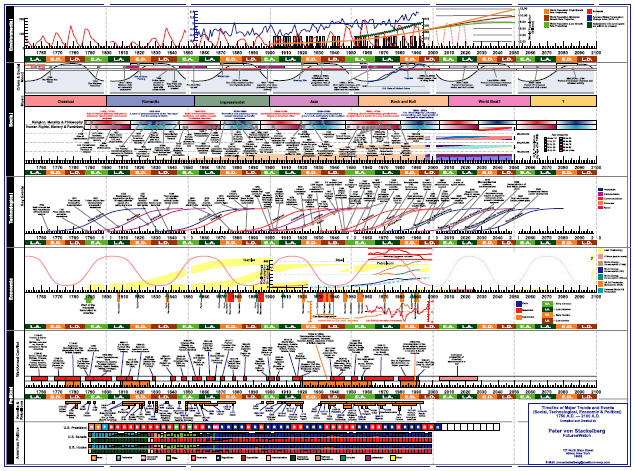
|
Futures Watch.
Full size (635 x 471; 140K);
PDF version (1175K);
Description:
Peter von Stackelberg designed this complex timeline of social, technological, economic and political
events and trends from 1750 to 2100.
Each time series shows graphs, events and categories on a common scale.
Peter says:
The purpose of the timeline is to provide a visual tool for looking at
events across a relatively long period of time and identify patterns and
interrelationships involving a broad range of factors. Identification of
patterns is particularly important when attempting to look at the future of
complex social, technological, economic, and other systems.
See Peter von Stackelberg: What I was thinking
for a more complete description of this timeline design.
|
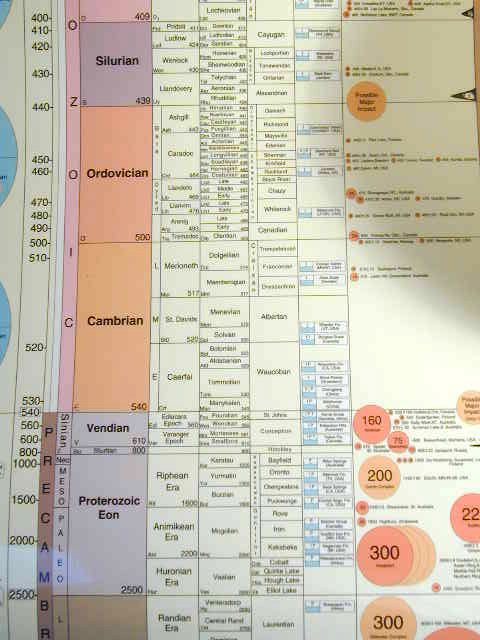
|
Correlated history of the earth.
Detail, full size (480 x 640; 58K)
Full poster (low-res) (321 x 432; 57K)
Description:
The poster, A Correlated History of the Earth,
shows a global view of the history of the earth over 4.5 billion years, on a logarithmic time scale.
Each column is a timeline from ancient times to recent. Included are
plate tectonic maps, mountain building events(orogenies), major volcanic
episodes, glacial epochs, all known craters from asteroid and comet
impacts, over 100 classic fossil localities from around the world,
fossils, ranges of plants, invertebrates and vertebrate lifeforms, and
major extinction events as revealed by the fossil record.
|
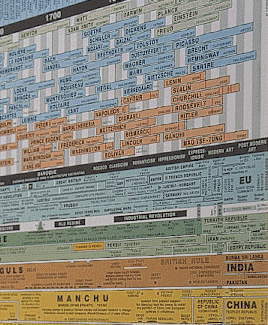
|
Synchronoptic History Chart.
Full size (270 x 500; 103K)
Description:
The Synchronoptic History Chart,
designed by Andreas Nothinger,
combines lifelines of individuals, parallel timelines of over 3000 events relating to science, culture and politics,
and 24 historical maps in a single chart.
There is an online version, HyperHistory Online illustrated below.
|
Linear time scales provide uniform resolution and detail across the entire time span, but events in time,
or our interest in them are rarely uniformly distributed.
Non-linear scales allow resolution to vary smoothly in some other way.
| Picture |
Words |
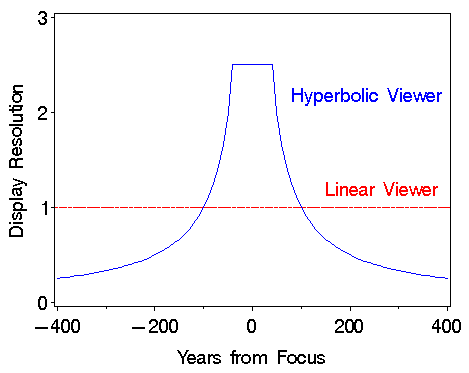
|
Hyperbolic viewer.
Full size (469 x 373; 4.8K)
Description:
This graph shows how a hyperbolic viewer design can smoothly decrease resolution in relationship to distance from
a focal point in time.
The principle is that
Resolution x Distance from focus = Constant.
The same idea applies to space, in two dimensions in the fish-eye map.
|

|
Logarithmic timeline.
Full size (800 x 244; 28K)
Description:
Heinz Von Foerster (1911-2002) designed this schema for showing all historical events over an enormous time scale
(from the Big Bang to today).
The timeline is laid out on a reverse log timescale, with dates and events spaced according to log (today - date).
Foerster used it both to present a large scale view of time, and to suggest that memories and details about the
past fade roughly in an exponential fashion.
|
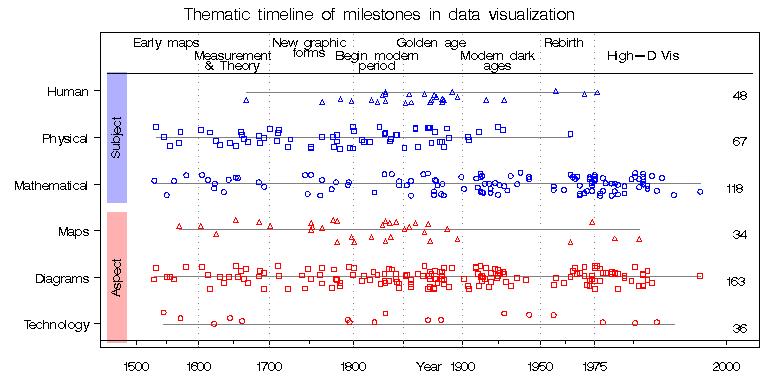
|
Milestones categorized timeline.
Full size (761 x 381; 58K)
Description:
Here we use a reverse square-root scale to show the time distributions of events in the
Milestones of Data Visualization, categorized by aspects of the
Form of innovation and its Content. This has the effect of spreading out more recent events
relative to older events, providing the possibility to show more detail of the former.
Positions on the horizontal time scale are spaced according to
the formula 2* (25 - sqrt(2000 - year)).
|
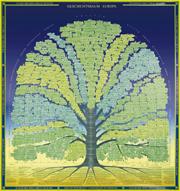
|
Geschictesbaum Europa - Tree view of European history
Full size (1000 x 1043; 390K)
Description:
A novel design is used in the Geschictesbaum Europa (author unknown)
to show a thematic view of the entire history of Europe in a tree structure.
With the base of the trunk at 0 A.D., branches for different countries (Germany, France, Spain, ...)
and domains of thought ( politics, church, culture) grow upward and outward. Dated events appear as the leaves
of the tree.
Events B.C. are shown under the roots of the tree.
This space-filling design automatically allows greater detail at the periphery, corresponding to more recent times.
Note that a linear scale for time, outward from the center, automatically provides space for detail proportional
to the square of distance from the origin.
|
| Picture |
Words |
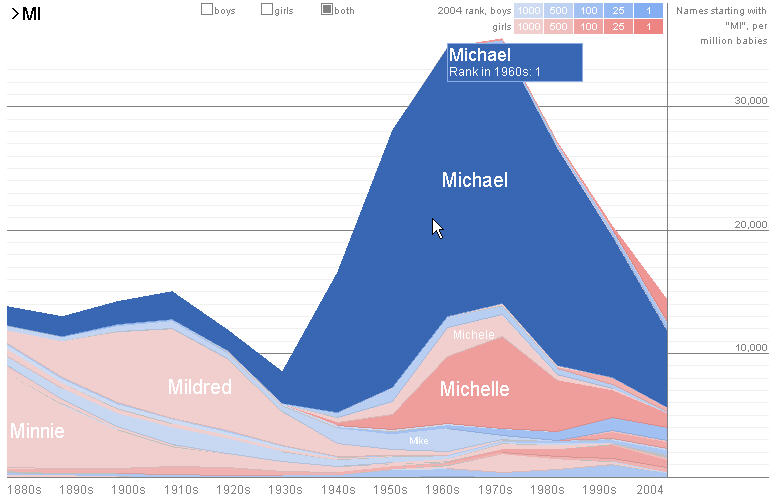
|
Baby Name Wizard: Name Voyager.
Full size (names: 'Mi' selected) (779 x 502; 55K);
All names view (777 x 503; 115K)
Description:
The Baby Name Wizard, NameVoyager is an interactive Java applet designed to show the time
distribution of the popularity of various male and female names over time. This image shows all names starting with the letters 'Mi'.
The vertical dimension shows the relative number of children given a particular name in each year,
so the varying heights of the colored bands indicates relative popularity.
The result is like a continuous version of a stacked bar-chart display.
|
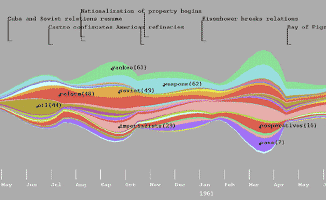
|
ThemeRiver.
Full size (675 x 414; 32K);
Theme River paper
Description:
Theme River
is a proof-of-concept application developed at Pacific Northwest Laboratories
for analysis of time-related
patterns, trends, and relationships across a large collection of
documents.
As in the Name Voyager,
the themes in the collection are represented by a "river"
that flows left to right through time. The river widens or narrows
to depict changes in the collective strength of selected themes in
the underlying documents. Individual themes are represented as colored
"currents" flowing within the river. The theme currents narrow or widen
to indicate changes in individual theme strength at any point in time.
|
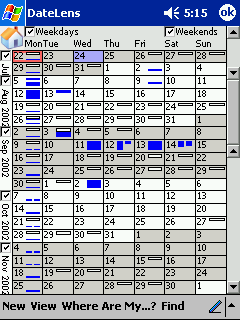
|
DateLens: A zoomable PDA calendar
Home view (240 x 320; 8.5K);
Month view (240 x 320; 6.8K);
Big view (240 x 320; 9.7K);
Focus view (240 x 320; 9.7K);
Description:
The Table Lens provides the means to visualize
large tables using a combination of zoom or focus plus context.
DateLens,
developed by Ben Bederson of the HCIL at the University of Maryland
applies these ideas to your calendar on a handheld PDA device or desktop application.
|
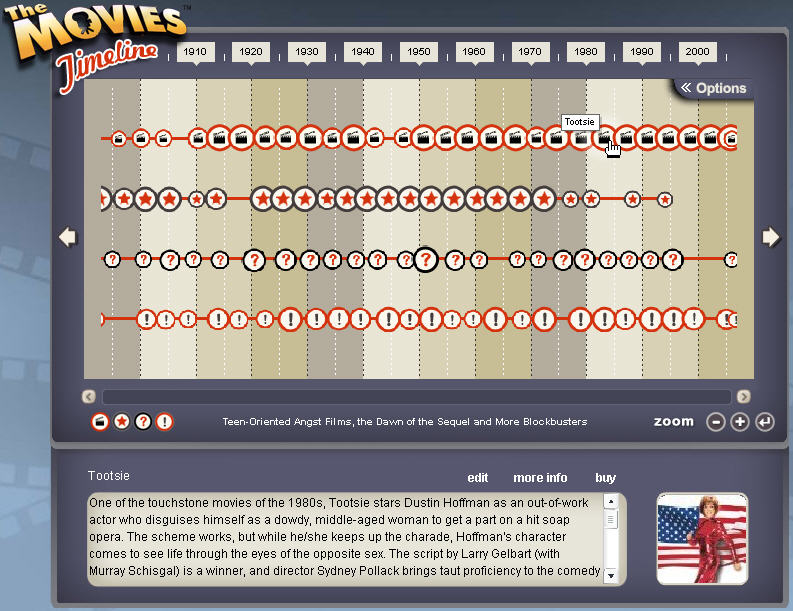
|
Movies Timeline.
Full size (793 x 611; 125K)
Description:
An interactive Flash proof-of-concept application by Patrick Mineault, www.5etdemi.com,
the Movie Timeline (no longer functional; see 5 1/2 blog)
provides parallel time scales for movies, stars, technological advances and cinematic events.
Zoom and un-zoom buttons allow the user to expand/contract the time scale around any given period.
|
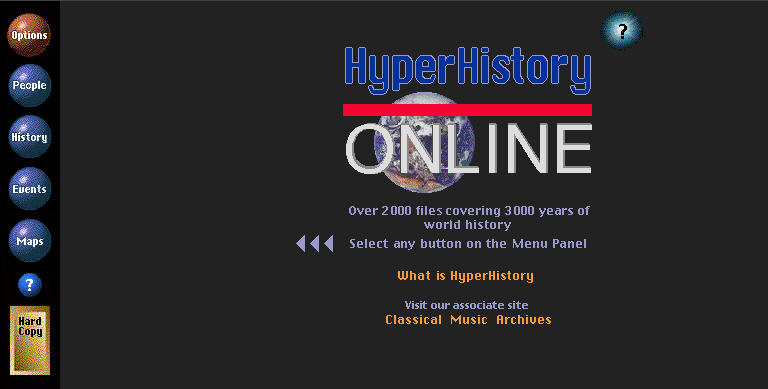
|
HyperHistory Online.
Opening screen (768 x 389; 38K);
Events in science ;
People in history ;
Description:
HyperHistory Online
provides multiple, linked views of 3,000 years of world history with an
interactive combination of parallel lifelines, timelines, and maps.
Each view can be zoomed to show more detail, people and events are color coded by categories, which can be
selected, etc.
|
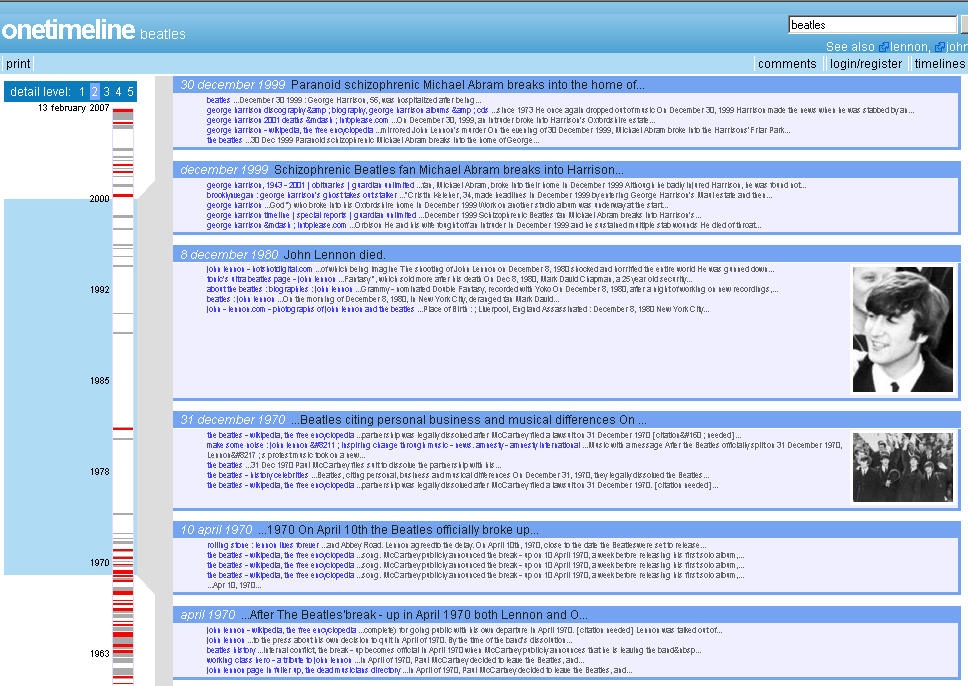
|
Onetimeline.
Full size (968 x 686; 197K)
Description:
Onetimeline
(now defunct)
operated as a web crawler that searches the web and classifies
events in time. When you search for a topic ("Beatles' in this image), it selects the relevant events
and displays them as a timeline, with a varying time-resolution scale at the left.
You can select one of 5 levels of detail with the Detail Level buttons at the top.
|
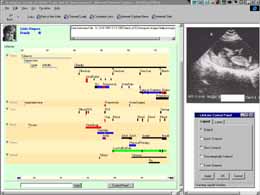
|
LifeLines: Visualizing Patient Records.
Full size (1024 x 768; 168K);
Other screen shots;
Technical report (PDF)
Description:
Lifelines is an interactive application
developed by Catherine Plaisant and others at the University of Maryland HCIL
for visualizing a patient's medical records and medical history.
A one screen overview of the record using timelines provides direct access
to the data. For a patient record, medical problems, hospitalization
and medications can be represented as horizontal lines, while icons
represent discrete events such as physician consultations, progress
notes or tests. Line color and thickness can illustrate relationships
or significance. Rescaling tools and filters allow users to focus on
part of the information, revealing more details.
|






